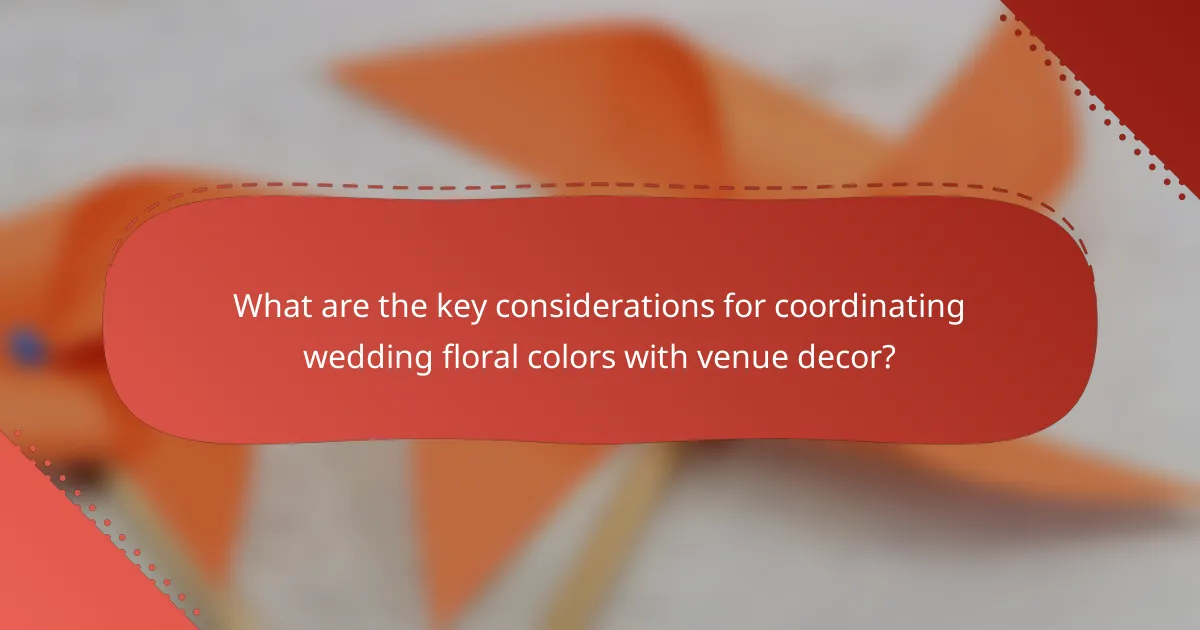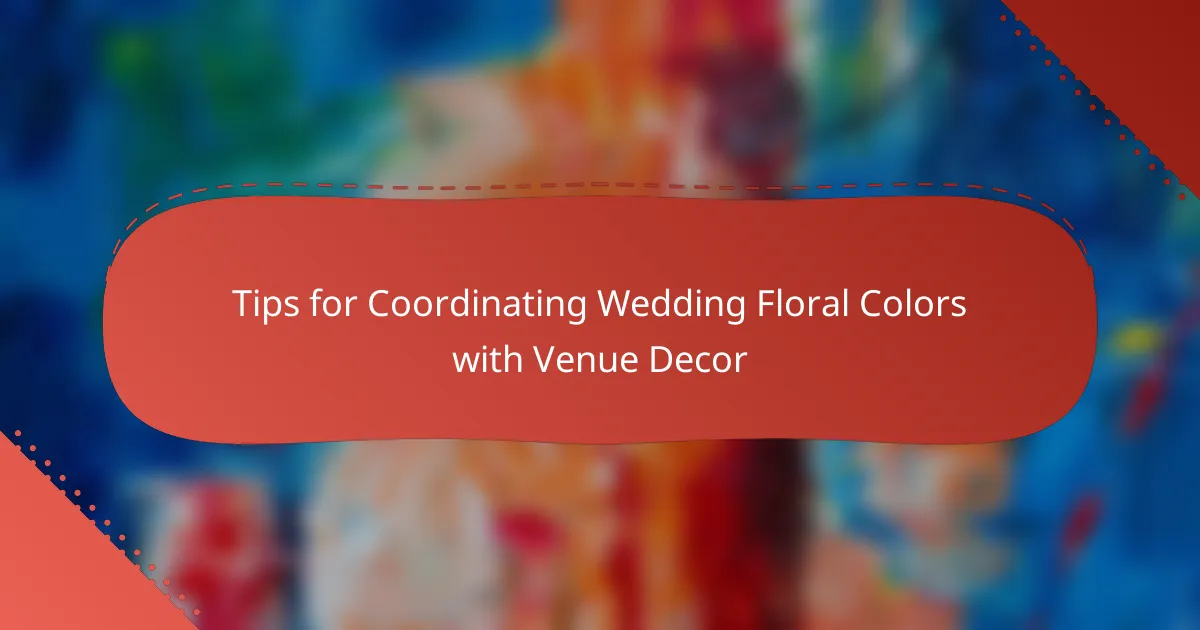
What are the key considerations for coordinating wedding floral colors with venue decor?
The key considerations for coordinating wedding floral colors with venue decor include color harmony, seasonal flowers, and venue style. Color harmony ensures that floral arrangements complement the existing decor palette. This can be achieved by selecting colors that are either analogous or complementary. Seasonal flowers provide natural beauty and freshness, aligning with the time of year and enhancing the overall aesthetic. The venue style, whether rustic, modern, or classic, influences floral design choices. Matching the floral arrangements to the venue’s architectural elements creates a cohesive look. Additionally, considering lighting conditions can impact how colors appear, making it essential to test floral samples in the venue’s lighting.
How do venue characteristics influence floral color choices?
Venue characteristics significantly influence floral color choices. The venue’s color scheme impacts the selection of floral hues. For instance, a venue with warm tones may lead to the choice of rich reds and oranges in floral arrangements. Conversely, a cooler venue palette might inspire selections of blues and purples. The lighting within the venue also affects color perception. Natural light can enhance vibrant colors, while dim lighting may soften them. Additionally, the style of the venue plays a role; a rustic venue may favor earth tones, while a modern space may lean towards bold, contemporary colors. Ultimately, the goal is to create harmony between the venue and floral arrangements, ensuring a cohesive aesthetic.
What are the different types of wedding venues and their decor styles?
Wedding venues include various types such as banquet halls, outdoor gardens, and beach resorts. Each venue type has distinct decor styles that complement their settings. Banquet halls often feature elegant chandeliers and formal table settings. Outdoor gardens typically embrace natural elements like flowers and greenery. Beach resorts usually incorporate a relaxed, tropical vibe with light fabrics and seashell accents. Historic buildings may showcase vintage decor with ornate details. Rustic barns often use wood elements and burlap for a cozy atmosphere. Each venue type influences the choice of floral colors and arrangements to enhance the overall aesthetic.
How does the season impact the choice of floral colors?
Seasonal variations significantly impact the choice of floral colors. In spring, pastel tones like soft pinks and light yellows are popular. Summer favors vibrant hues such as bright reds and oranges. Autumn brings rich colors like deep reds and burnt oranges. Winter often sees whites and deep jewel tones like emerald and burgundy. These color preferences align with nature’s transitions throughout the year. For instance, spring flowers bloom in lighter shades, reflecting renewal. Seasonal color trends also influence wedding themes, making florals a crucial element in decor coordination.
What are the best practices for selecting floral colors that complement venue decor?
The best practices for selecting floral colors that complement venue decor include analyzing the venue’s color palette. Identify the dominant colors in the venue. Choose floral colors that harmonize with these shades. Consider the season and its influence on color choices. Utilize color theory to create contrast or cohesion. Soft pastels work well in light venues, while bold colors suit darker spaces. Test floral arrangements against venue decor for visual compatibility. Finally, consult with a floral designer for expert advice on color matching.
How can color theory be applied to floral arrangements and venue decor?
Color theory can enhance floral arrangements and venue decor by creating visual harmony. Utilizing complementary colors can draw attention and create balance. For example, pairing blue flowers with orange decor can create a striking contrast. Analogous colors, like red, pink, and peach, can evoke a sense of unity. Monochromatic schemes, using various shades of a single color, can create a sophisticated look. Color psychology also plays a role; warm colors can evoke energy, while cool colors promote calmness. Research indicates that color combinations impact mood and perception, making thoughtful choices essential for event aesthetics.
What role do lighting and ambiance play in color coordination?
Lighting and ambiance significantly influence color coordination by altering the perception of colors. Different lighting conditions can enhance or diminish certain hues. For example, warm lighting can make colors appear softer and more inviting. In contrast, cool lighting can create a more vibrant and energetic feel. The ambiance of a venue also sets the mood, impacting how colors are perceived together. Studies show that color appearance changes under various light sources, highlighting the importance of lighting in design choices. Properly coordinated lighting can enhance floral arrangements and decor, ensuring a cohesive aesthetic for weddings.
What specific floral color combinations work well with various venue styles?
Romantic venues pair well with soft pinks and whites. These colors create a gentle and intimate atmosphere. Rustic venues benefit from earthy tones like burgundy and sage green. This combination enhances the natural, organic feel of the space. Modern venues often use bold colors such as navy and gold. These shades add a touch of elegance and sophistication. Beach venues look great with vibrant turquoise and coral. This combination reflects the colors of the ocean and sunset. Classic venues favor timeless combinations like red and white. These colors evoke a sense of tradition and formality.
Which floral colors are ideal for rustic venues?
Earthy tones are ideal for floral arrangements in rustic venues. Colors like deep reds, burnt oranges, and muted yellows complement natural materials. Soft pastels, such as blush pink and lavender, also enhance rustic charm. Greenery plays a vital role, adding freshness and texture. These colors harmonize with wooden elements and vintage decor. Seasonal flowers in these shades create a cohesive look. Research indicates that color palettes in harmony with venue decor enhance overall aesthetics. Choosing floral colors that reflect the venue’s rustic character is essential for a successful design.
How can modern venues benefit from specific floral color palettes?
Modern venues can benefit from specific floral color palettes by enhancing their aesthetic appeal. A well-chosen color palette can create a cohesive look that aligns with the venue’s design. For instance, venues with neutral tones can be complemented by vibrant floral arrangements to add visual interest. Conversely, venues with bold colors can benefit from softer floral hues to balance the overall atmosphere. Research indicates that color harmony can influence guests’ emotions and perceptions, making the event more memorable. Specific floral colors can also reinforce the theme of the event, ensuring a unified experience. Additionally, the right palette can improve photography outcomes, capturing the venue’s beauty effectively. Thus, utilizing specific floral color palettes is a strategic approach for modern venues to elevate their overall presentation and guest experience.
How can couples effectively communicate their floral color vision to florists and decorators?
Couples can effectively communicate their floral color vision by providing clear examples and specific color references. They should create a mood board that includes images of desired floral arrangements and color palettes. This visual aid helps florists and decorators understand their preferences. Couples can also use color codes, such as Pantone numbers, to specify exact shades. Discussing the overall theme and style of the wedding further clarifies their vision. Effective communication includes being open to suggestions while staying true to their preferences. Engaging in a dialogue about the meaning behind color choices can enhance understanding. Ultimately, clear and consistent communication leads to successful floral arrangements that match the couple’s vision.
What common mistakes should be avoided when coordinating floral colors with venue decor?
Common mistakes to avoid when coordinating floral colors with venue decor include mismatching colors. This can lead to a disjointed aesthetic. Another mistake is ignoring the venue’s existing color palette. This oversight can clash with the overall theme. Overlooking the season’s color trends is also a frequent error. Seasonal flowers often enhance the decor’s appeal. Additionally, using too many colors can create visual chaos. A cohesive color scheme is essential for elegance. Lastly, failing to consider lighting effects on colors can alter perceptions. Proper lighting can enhance or diminish floral hues.
How can over-saturation or clashing colors be prevented?
To prevent over-saturation or clashing colors, use a color palette with complementary hues. Select a maximum of three main colors to maintain harmony. Incorporate neutral tones to balance vibrant shades. Test color combinations in natural light to assess their interaction. Utilize color theory principles, such as the color wheel, for guidance. Consider the venue’s existing decor to ensure compatibility. Limit the use of bold colors to focal points, allowing for visual relief. Research shows that cohesive color schemes enhance overall aesthetic appeal in event design.
What are the signs of poor color coordination in wedding decor?
Signs of poor color coordination in wedding decor include clashing colors that do not complement each other. For example, bright red and neon green can create a jarring visual effect. Another sign is the use of too many colors that overwhelm the decor. A balanced palette typically includes 2-4 colors. Additionally, colors that do not match the venue’s ambiance can detract from the overall aesthetic. For instance, pastel colors in a rustic barn setting may feel out of place. Lastly, mismatched shades of the same color can indicate poor coordination. For example, using different shades of blue can create a disjointed look instead of a cohesive theme.
What practical tips can help ensure successful floral color coordination for weddings?
Select a color palette that complements the wedding theme. Consider the venue’s colors and decor style. Use a color wheel to identify harmonious shades. Incorporate a mix of primary and secondary colors for depth. Choose flowers in various shades of the selected colors. This adds dimension and interest. Consult with a florist for expert advice. They can suggest seasonal blooms that fit the palette. Test floral arrangements in the venue space. This helps visualize the final look and make adjustments.
The main entity of the article is the coordination of wedding floral colors with venue decor. Key considerations include achieving color harmony, utilizing seasonal flowers, and aligning floral designs with the venue’s style. The article explores how venue characteristics, seasonal influences, and lighting conditions impact floral color choices. It also provides best practices for selecting complementary floral colors, highlights common mistakes to avoid, and offers practical tips for successful coordination. Overall, the content aims to guide couples in creating a cohesive aesthetic for their wedding decor.
